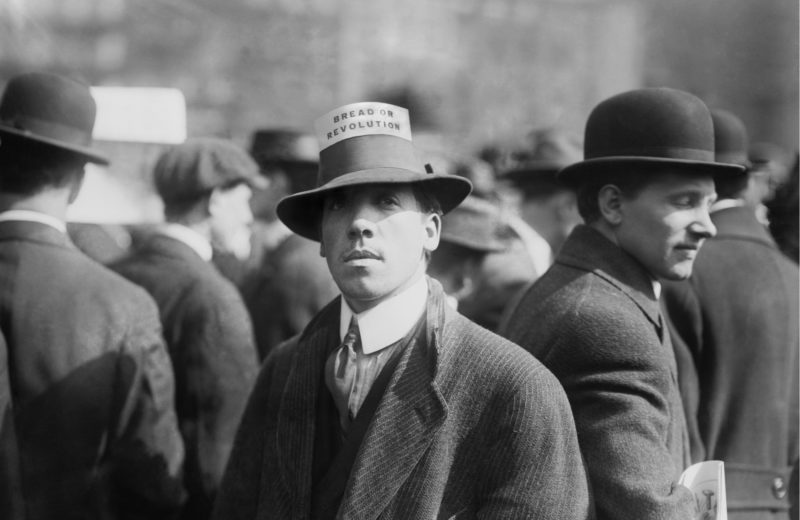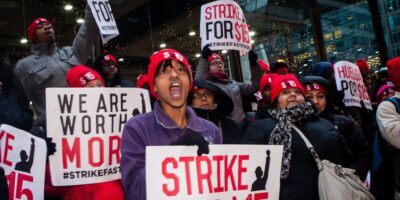Labor Unions, RIP

“Beaucoup de trafic!” the Uber driver sighed with exasperation, looking at me in the back seat via the rear view mirror. I nodded and shrugged; before arriving in Paris early this week, I had been warned about la grève — the widespread strikes in response to the Macron government’s announcement of pension reform — but this was far beyond what I had expected.
I wound up spending almost three hours in that Uber to travel 19 miles, with my driver equally surprised by the gridlock that the mass transportation strike was producing.
It seems surprising that with the Greek debacle less than five years behind us, a debate over lavish, publicly-financed retirements in Europe which defy any actuarial or demographic sense — anywhere, really — could find footing. It won’t for very long. The age of unions, once characterized by numbers but increasingly by volume, is grinding to a halt.
Private and public sector unions
The basic game theoretic of collective bargaining against corporate entities or industries has a limiting factor: budgets. Unions can, and occasionally have, killed the golden goose, and so unless the government intervenes, there is a natural tension between business owners and labor in their mutual reliance upon financial wherewithal: workers (understandably) want to maximize their earnings, while firms exist to produce and maximize their profits. Yet at some point, the risk vs.return proposition must come into effect, and if profits (after a number of accounting treatments and considerations) do not exceed nominally risk-free rates — typically that of a sovereign bond issue, like the US 10-year Treasury bond — the owner may decide to engage the so-called shutdown decision.
In the very short term, yes: unions may bring about higher wages and more benefits for workers. They do this, quite simply, by restricting the supply of labor, increasing the demand for labor, or both. But the cartelization of labor comes with several costs: the first is that by increasing wages, returns on investment are lowered: more specifically, net income (profit) is reduced to economically mundane levels. Because of this, corporate investment tends to shift away from sectors dominated by collective bargaining, which over time leads to unions sucking the life out of once vibrant industries. In the United States, that fate befell steel, automobiles, railroads, clothing and textile production, many types of mining, and other industries. That is why so many of those industries have relocated or outsourced their labor to places where wages (and benefits, if any) are lower. It is also why many late-career, long-time union members suddenly find themselves unemployed with no prospects for re-employment.
Symmetrically, labor unions are subject to the same outcomes that long-term contracts bring about in other organizations: insulation, complacency, and inertia. Since the 1990s, the unit of time that innovation cycles are measured in days; not years or even decades, as was the case in the World War II era. In light of that, the mounting complicacy of union agreements over the same time period – in the case of the UAW-Ford Master Contract from 24 pages (1941) to 2,215 (2007) – borders on inconceivable, and speaks either to utter vacuity, contemptuousness, or desperation.
In an era of blockchain, algorithms, quantum computing, drone deliveries, artificial intelligence, big data, 3D printing, and so on, all surrounded by a rapidly expanding number of nonemployer establishments (firms tapping into the “gig economy”), documents spanning thousands of pages (and covering hundreds of thousands or millions of individuals, professedly for terms spanning decades), are utterly primordial.
Public sector unions pose many of the same conflicts that private sector unions do, but with public sector unions taxation, inflation, and regulatory powers are brought to bear. Public sector unions also come with a set of unintended consequences which are as disconcerting as the immediate, economic ones are.
Labor as pawn – and prey
Aside from being wholly inimical to liberty and personal choice, one of the messages sent by compulsory union membership is of inherent conflict between capital and labor. But the dynamic is deeper and more insidious than a simple and straightforward battle between labor and capital (or, more archaically, between labor and “high finance”) that is ordinarily invoked — ordinarily when the inability to opt out of a union is questioned. Unions, whether in the public or private sector, are a foil for political interests: usually left-wing, but in any case less espousing of working interests than those of the academic, intellectual, and governmental realms.
The rapid pace of technological innovation, and the transparency brought about by the internet, have made the 19th century stereotypes of tops-and-tails wearing oligarchs wielding dictatorial power over beleaguered masses absurd. And one suspects that although not formally taught (and in fact, militated against in some circles), many young people see the benefits of the marketplace in the form of Amazon, Hulu, Tesla, Uber, and hundreds of other firms and products daily.
Much could be done for the so-called working class — itself a taxonomization increasingly blurred by the rapidly changing market for skills and abilities — by winding down licensure restrictions, deregulating healthcare, arresting inflation, and, yes: lowering taxes. Fortunately for most union workers, the ossifying effects of collective bargaining have been offset, most ironically, by the very fiends their delegates and shop stewards indict: the low cost, highly competitive goods and services flowing out of Walmart, Amazon, and China.
Even more could be done by inculcating young people with a sense of their individual value and an appreciation for the effects of competitiveness in the workplace.
It Continues, But Not For Long
On the morning before I left France, signs appeared in the lobby stating that owing to the ongoing strike, lunch and dinner in the hotel restaurant were cancelled. Many of the guests — French, English, and American, some elderly and some with small children — complained. I’d ask union officials (anywhere) which of the following outcomes they believe are more likely: that these people, most of whom are in an unfamiliar country and having budgeted their stays and made plans, will find common ground with the workers, considering their inconvenience and lost opportunities a worthy price to pay for the fulfillment of unrealistic, unsustainable pension schemes?
Or will they, even if not spiteful of the striking workers (which many incontestably were) be thankful for markets, which are helping them salvage otherwise lost aspects of their trips and vacations? For me, ride-sharing apps and affordable local dining options deflected most of the impact of la grève.
The future is bright for choice, competition, and individual enfranchisement in the workplace. And lest anyone forget, the law of demand has not and will not be repealed. This is as much a description of the major operandus of unions as it is a description of a continuing trend. The pace of commercial transformation has made the institution of collective bargaining more of a liability to the few remaining workers covered by them than anything corporations, private equity firms, or “neoliberal” policies could or have wrought.
Workers of the world, untie: the chains are not so much to be broken as to continue to slip off on their own.










